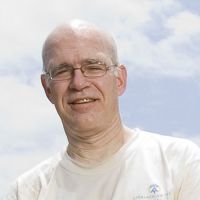Richter presents talk at Stanford
08 Sep 2014
News Source: Stanford University School of Earth Sciences
Dan Richter gave a seminar in May 2014 at Stanford University’s Department of Environmental Earth System Science entitled “The changing models of soil, the ecosystem, and Earth’s Critical Zone.”
Abstract: Recently, Dan Yaalon and Dan Richter published the paper, “The Changing Model of Soil” to commemorate a 1961 paper with the same name written by soil scientist, Marlon Cline, long-time pedology professor at Cornell. Here, we expand on the argument that in the advent of the Anthropocene, human forcings have fundamentally transformed Earth’s soil and the science of soil, i.e., from pedology to anthro-pedology, from a natural science to one that is basic, applied, and interdisciplinary, actively interacting with the social sciences and humanities. Earth’s soil is today a biogeochemically excited Earth-surface system, a dynamic, polygenetic, and archival human-natural body. We hypothesize that in the Anthropocene, similar transformations are ongoing in other disciplines across the academy. To examine this idea we consider the changing model of the ecosystem, and observe an on-going integration of human beings in the ecosystem concept but also an expansion the ecosystem’s temporal scales of interest and spatial scales well below plant-rooting zones to the deepest penetration of biological signals. Remarkably, geoscientists have recently conceptualized such a system they call Earth’s Critical Zone, the integrated human-natural system that includes atmosphere, biota, soil, and the full weathering zone of the planet. We propose that the Earth’s Critical Zone is entirely compatible with Tansley’s and Lindeman’s concept of ecosystem [e.g., Tansley’s (1935) “the whole system (in the sense of physics)”], and that positive interactions can be reaped by ecosystem and CZ scientists from a consideration of terrestrial ecosystem metabolism. Ecosystem metabolism concerns energy flows through plant production and respiration and thus terrestrial ecosystems have traditionally included plants and animals, and landscapes and soils of the belowground root zone. While most CO2 from respiration returns to the aboveground atmosphere, the gas can also diffuse well below the root zone, sometimes 10s of meters, and due to elevated concentrations, drive carbonic acid weathering. These reactions are fundamental to crustal weathering and global elemental cycling, they are not often studied by ecosystem scientists and represent a kind of unfinished business in the study of ecosystem metabolism. The Earth’s Critical Zone explicitly includes such deep volumes and from this perspective it has been shortsighted to bound the ecosystem by “rooting depth”. We encourage eco- and geo-scholars to get on with a needed reconciliation and hybridization of their sciences.
News Source:
READ MORE from Stanford University School of Earth Sciences >>
News Category:
EDUCATION/OUTREACH
Publications
2012
“The Changing Model of Soil” Revisited. Richter, Daniel deB., and Dan H. Yaalon (2012): Soil Science Society of America Journal 76 (3):766-778
Explore Further



